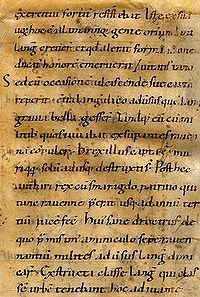Historia Langobardorum
| History of the Lombards | |
|---|---|
| Historia Langobardorum Historia gentis Langobardorum |
|

Salzburg manuscript
|
|
| Author(s) | Paul the Deacon |
| Language | Latin |
| Date | 787–796 |
| Provenance | Monte Cassino |
| Manuscript(s) | 115 extant manuscripts |
| Principal manuscript(s) | Codex Sangallensis 635 |
| First printed edition | 1514 |
| Genre | Ethnic history |
| Subject | History of the Lombard people |
The History of the Lombards or the History of the Langobards (Latin: Historia Langobardorum) is the chief work by Paul the Deacon, written in the late 8th century. This incomplete history in six books was written after 787 and at any rate no later than 796, maybe at Montecassino.
The history covers the story of the Lombards from their mythical origins to the death of King Liutprand in 743, and contains much information about the Byzantine empire, the Franks, and others. The story is told from the point of view of a Lombard patriot and is especially valuable for its treatment of the relations between the Franks and the Lombards. As his primary sources, Paul used the document called the Origo gentis Langobardorum, the Liber pontificalis, the lost history of Secundus of Trent, and the lost annals of Benevento; he also made free use of works by Bede, Gregory of Tours, and Isidore of Seville.
According to a study made by Laura Pani in 2000, there are 115 surviving codices of Paul's history. A popular work in the Middle Ages, as indicated by the number of copies and their dissemination throughout Western Europe, more than twenty of these manuscripts predate the 11th century while another eighty or more were copied later.
The relations between these manuscripts were studied by Georg Waitz, who in 1876 identified 11 different families of the Historia Langobardorum. The oldest manuscript is the Palimpsest of Assisi, written in the uncial script towards the end of the 8th century, almost immediately after Paul's work was completed. This palimpsest is, however, far from complete, as it contains only parts of books II and V of Paul's history. The earliest complete manuscript is the Codex Sangallensis 635 written sometime between the 8th and the 10th centuries and designated by Waitz as F1. According to Waitz, F1's age makes it the most reliable of the Historia's codices, a view which has been challenged by Antonio Zanella and Dante Bianchi, both of whom hold that the F1 does not correctly reflect Paul's original.
...
Wikipedia
